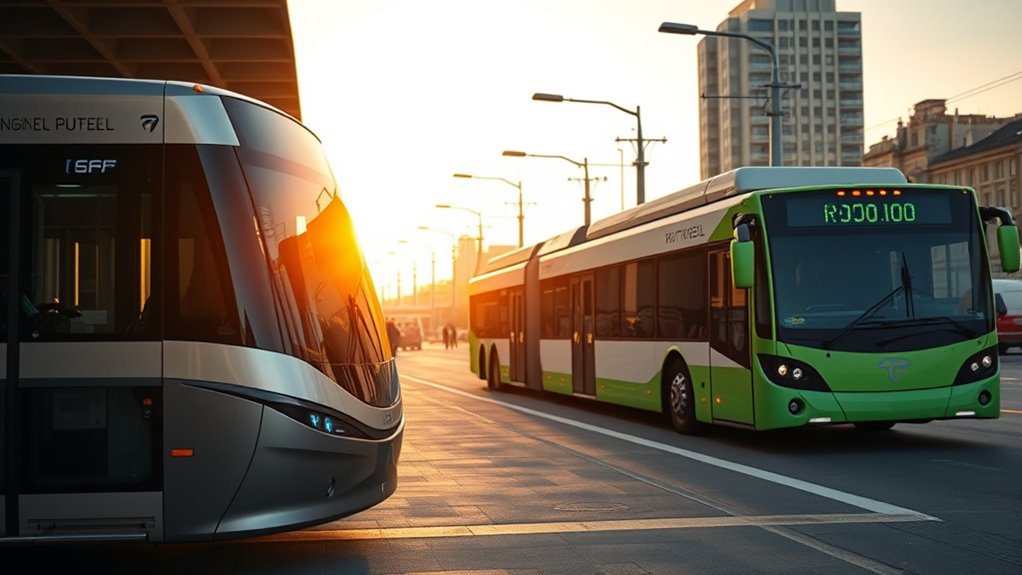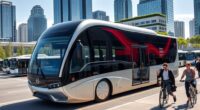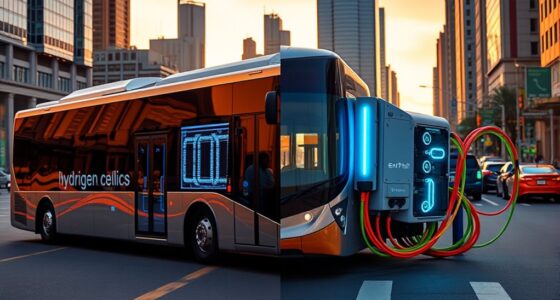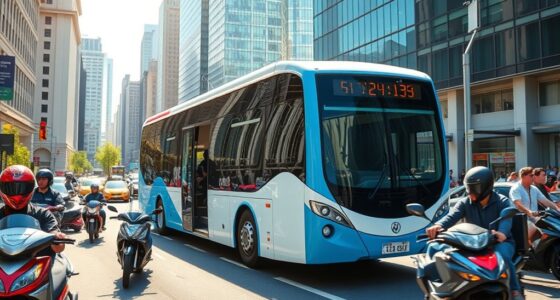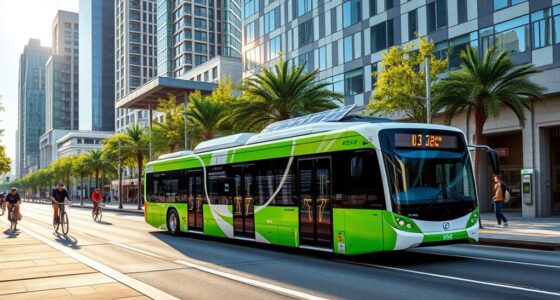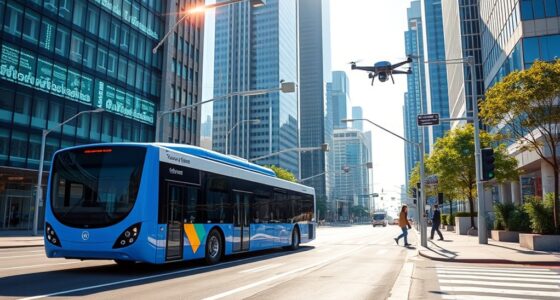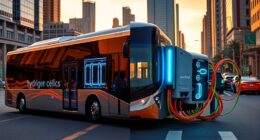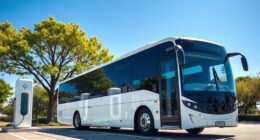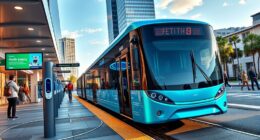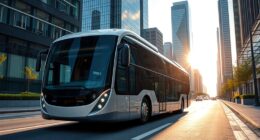Hydrogen fuel cell buses excel with longer range, quick refueling, and better performance in extreme temperatures, but they require costly infrastructure and rely on fossil-fuel-based hydrogen production. Battery electric buses are more efficient, cheaper to operate, and easier to deploy due to widespread charging networks, though they face limitations in range and charging time. To understand how these technologies compare in sustainability, cost, and future potential, keep exploring the key differences and innovations shaping their roles.
Key Takeaways
- BEBs offer higher efficiency and lower operational costs, making them more suitable for urban routes with frequent stops.
- FCEBs provide longer range and quick refueling, ideal for extensive routes and services requiring minimal downtime.
- Hydrogen infrastructure is limited and costly, posing scalability challenges despite the technology’s long-term environmental potential.
- Advances in fuel cell technology and renewable hydrogen production are improving FCEBs’ environmental and economic competitiveness.
- Public perception, policy support, and infrastructure development are critical factors influencing the adoption potential of both bus types.
Comparing Efficiency and Environmental Impact
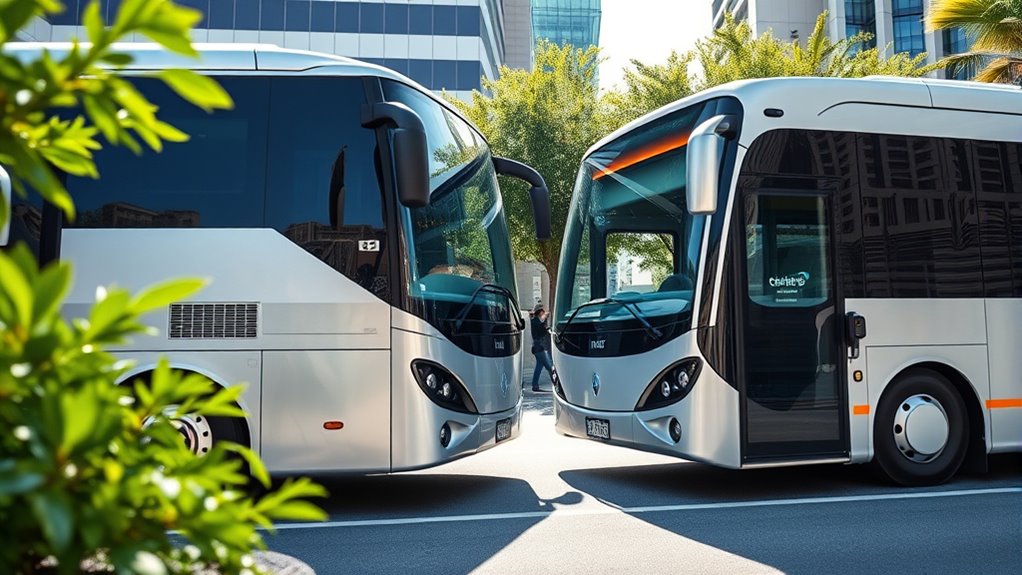
When comparing the efficiency and environmental impact of hydrogen fuel cell buses (FCEBs) and battery electric buses (BEBs), it’s clear that BEBs generally outperform FCEBs in efficiency.
BEBs achieve higher tank-to-wheel efficiencies, around 137 to 154 kWh per 100 km, whereas FCEBs consume approximately 310 to 335 kWh per 100 km due to energy conversions involved in producing and using hydrogen. Energy conversion processes significantly influence overall efficiency ratings, and advancements in energy storage technology continue to improve performance.
Both bus types produce zero tailpipe emissions, making them environmentally friendly options. However, their life cycle emissions depend on how hydrogen and batteries are produced. Energy source plays a crucial role in determining the overall environmental benefits of each type.
Operational Advantages and Challenges

Hydrogen fuel cell buses offer notable operational advantages, primarily due to their long range and quick refueling times. With a range exceeding 350-400 km, you can operate them on long routes without frequent stops. Wave and wind play a role in the natural processes that influence the production and distribution of hydrogen fuel, impacting the sustainability of hydrogen fuel cell technology. Refueling takes about 15 minutes, with some systems as quick as 7-10 minutes, allowing you to minimize downtime. This enables consistent service levels and makes them suitable for replacing diesel or CNG buses one-to-one without disrupting routes. Their reliable performance ensures schedules stay on track, providing operational flexibility. Efficiency in fueling is a key benefit that contributes to their operational appeal, especially in busy transit systems. However, infrastructure development remains a challenge, as hydrogen refueling stations are limited, costly to build, and require specialized safety measures. Additionally, hydrogen production often relies on fossil fuels, which can impact environmental benefits. Environmental impact is a critical consideration when evaluating the overall sustainability of hydrogen fuel cell buses. Moreover, ongoing research aims to improve the cost-effectiveness of hydrogen production and storage, which could enhance the technology’s viability in the future.
Cost Considerations and Long-term Savings
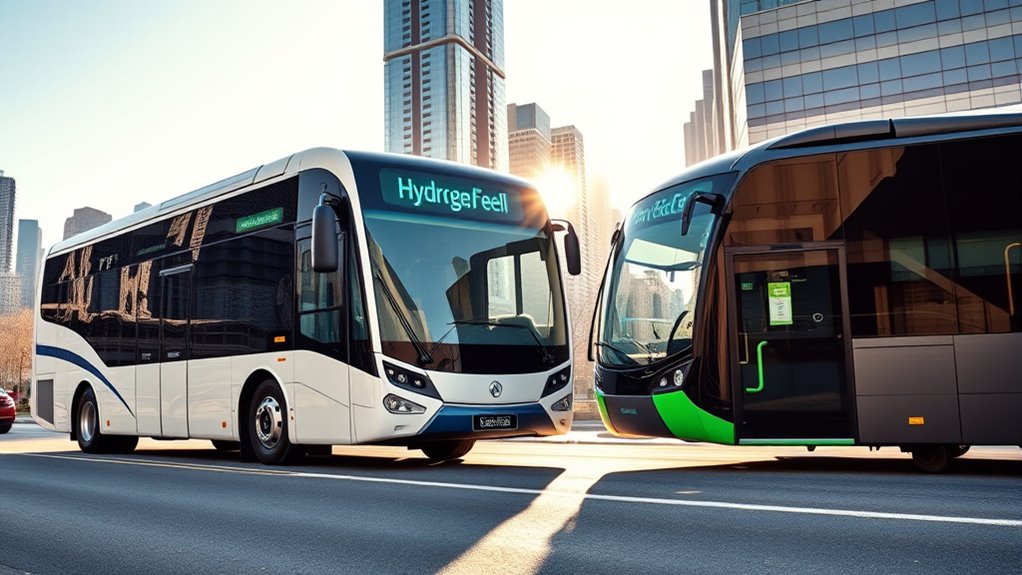
While hydrogen fuel cell buses excel in operational performance, their higher initial purchase price influences long-term financial considerations. They cost around €650,000, about 17% more than battery-electric buses, and their total ownership over 15 years reaches approximately €1.3 million—significantly higher than the €972,000 for electric buses. Fuel expenses also weigh heavily; hydrogen costs €10–€14 per kilogram, and fuel cell buses consume more energy per kilometer, raising operational costs. In addition, the energy efficiency of battery-electric buses contributes to their lower overall operating expenses. Battery-electric buses also benefit from technological advancements, further reducing maintenance costs and increasing their cost-effectiveness. These advancements enhance battery technology longevity and performance, making electric buses increasingly viable. Moreover, the cost of infrastructure for charging stations is generally lower and easier to implement than hydrogen refueling stations, boosting the economic appeal of electric buses. In contrast, battery-electric buses have lower energy and maintenance costs, saving roughly €394,800 per bus over 15 years. Their higher efficiency and lower fuel costs make them more cost-effective long-term options, especially considering their lower per-hour operating costs of about $167 compared to $390 for hydrogen buses.
Technological Innovations Shaping the Future
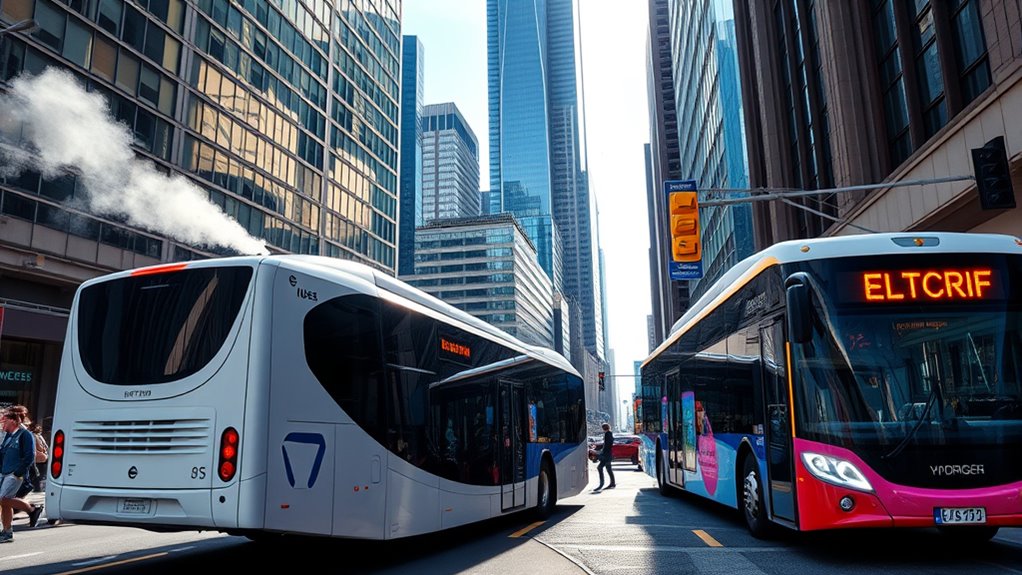
Recent technological innovations are transforming hydrogen fuel cell buses and battery electric buses, making them more efficient and practical for a wider range of applications. Advances in fuel cell design have produced lighter, more efficient modules, boosting performance and enabling longer routes without refueling.
Energy recovery systems, like high-grade electric drive traction, improve efficiency and reduce component wear. Simplified system integration streamlines maintenance and cuts operational costs.
On the battery side, new technologies offer extended ranges, faster charging, and lighter materials that increase efficiency. Modular battery packs enable upgrades and customization, while regenerative braking captures energy to optimize performance.
These innovations collectively enhance route flexibility, weather tolerance, and operational stability, driving both hydrogen and electric buses toward becoming more versatile and cost-effective transportation solutions. Incorporating nail tips techniques can serve as a useful analogy for the layered and detailed improvements seen in these advanced systems.
Infrastructure Development and Deployment
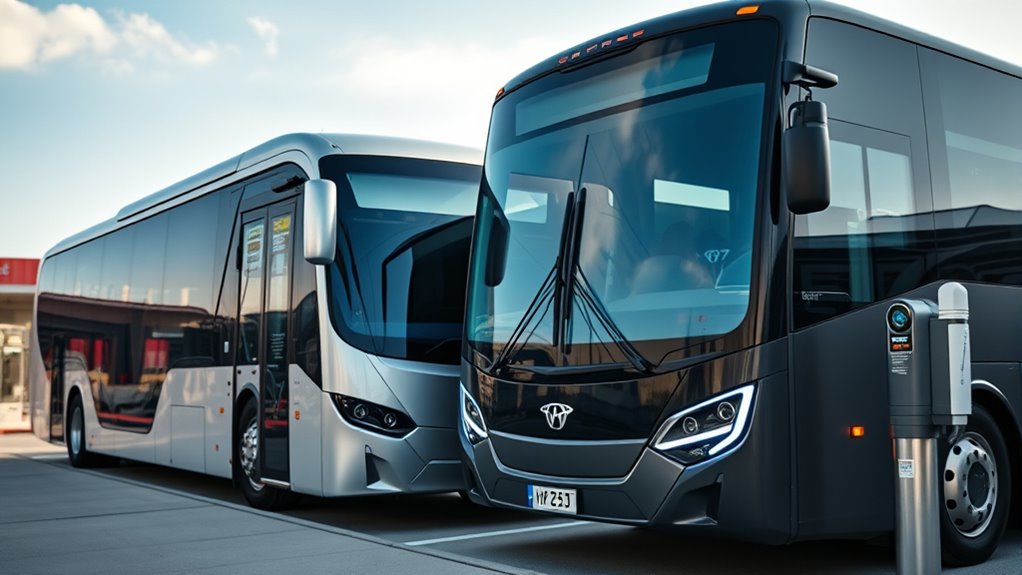
Building a robust infrastructure is vital for the widespread adoption of hydrogen fuel cell buses. Currently, over 370 fuel cell buses operate in Europe, with plans to expand to over 1,200 by 2025.
A strong infrastructure is essential for expanding hydrogen fuel cell bus adoption worldwide.
Hydrogen fueling stations can refuel multiple buses quickly, sometimes up to 40 in just 10-20 minutes, making operations efficient. This rapid refueling capability is essential for maintaining service schedules and reducing downtime.
Deployment strategies include partnerships with transit agencies and regional hydrogen hubs, which help manage large-scale growth. These hubs facilitate the distribution and storage of hydrogen, improving overall system efficiency. Effective distribution methods are crucial for scaling up hydrogen infrastructure nationwide. Additionally, establishing standardized safety protocols is critical to ensure safe handling and operation of hydrogen fueling stations.
Demonstration projects showcase technology feasibility, while real-time monitoring software improves station and bus efficiency. Such innovations help optimize energy use and ensure safety standards are maintained.
Funding initiatives support infrastructure expansion, but challenges like high upfront costs and scalability remain. Addressing these issues through investment and policy support can accelerate progress.
Developing extensive hydrogen infrastructure now is indispensable to guarantee the successful deployment and long-term viability of fuel cell bus fleets. Incorporating cooking concepts such as efficient fuel management and energy optimization can further enhance the performance and sustainability of these transportation solutions.
Policy Support and Market Adoption

Policy support plays a pivotal role in accelerating the adoption of hydrogen fuel cell buses, with federal programs like the “Hydrogen Shot” and FTA grants providing essential funding. These initiatives lower hydrogen costs and promote zero-emission transit solutions.
The National Fuel Cell Bus Program encourages adoption through targeted funding and innovation, while regional Hydrogen Hubs like ARCHES support infrastructure development and market growth. Diverse vehicle options can cater to different transit needs, broadening the appeal of alternative fuel buses.
Incentives at federal and state levels further motivate transit agencies to transition to hydrogen technology. Market adoption is expanding rapidly, with over 90,000 fuel cell electric vehicles on the roads, including buses. Hydrogen fuel cell technology continues to advance, leading to increased efficiency and decreasing costs, making these buses more competitive with traditional options.
Research into sound healing science indicates that harnessing specific frequencies can also support health and well-being, potentially offering complementary benefits for transit workers and passengers. Additionally, advances in fuel cell technology continue to improve efficiency and reduce costs, making these buses more competitive with traditional options.
Public transportation makes up 17% of these vehicles, and future plans aim to deploy over 1,000 fuel cell buses. Policy support is indispensable for sustaining this growth and fostering technological advancements.
Public Perception and Acceptance

Public perception plays a crucial role in the widespread adoption of hydrogen fuel cell and battery-electric buses, as how you view these technologies influences their acceptance and success. Many recognize battery-electric buses for their efficiency and zero emissions, which boosts public support for cleaner transportation.
However, concerns about charging times and range limitations impact acceptance, especially compared to hydrogen buses’ quick refueling. Awareness of infrastructure availability also matters; widespread charging stations increase confidence in electric options, while limited hydrogen stations hinder perception.
Environmental benefits, such as reduced emissions, resonate positively when clearly communicated. Additionally, the perceived long-term viability and technological advancements shape public opinion. Understanding the effectiveness of eye patches and their role in skincare can influence perceptions of health-related technologies, emphasizing the importance of reliable and scientifically supported solutions.
Furthermore, public understanding of technology readiness and ongoing development efforts can significantly affect acceptance levels, as people tend to trust innovations backed by credible research and proven results.
Addressing Future Challenges and Opportunities

As the adoption of hydrogen fuel cell and battery-electric buses advances, understanding their future challenges and opportunities becomes key to shaping sustainable transportation. Infrastructure remains a major hurdle: hydrogen refueling stations are costly and limited, while electric buses leverage existing grids but strain local power supplies during peak times.
Hydrogen supply chains are underdeveloped compared to electricity networks, complicating scalability. Technologically, electric buses are more efficient, but hydrogen buses perform better in extreme temperatures.
Cost-wise, electric buses have lower lifetime expenses and benefit from falling battery prices, whereas hydrogen buses face high fuel and infrastructure costs. Both technologies can reduce emissions if powered by renewables, but hydrogen’s energy input per mile remains higher.
Addressing these challenges will unbolt their full potential and shape the future of clean transit.
Frequently Asked Questions
How Do Maintenance Requirements Differ Between Hydrogen Fuel Cell and Battery-Electric Buses?
You’ll find maintenance requirements differ mainly in safety protocols and system checks. Hydrogen buses need explosion-proof equipment, hydrogen leak detection, and strict ventilation, with daily fuel cell inspections and specialized tools.
Battery electric buses focus on high-voltage safety, thermal management, and battery diagnostics, requiring regular checks of cell balancing and cooling systems.
Hydrogen systems have quicker refueling but more complex safety measures, while batteries need longer recharging but simpler safety protocols.
What Are the Safety Concerns Associated With Hydrogen Storage and Refueling?
You should be aware that hydrogen storage and refueling pose safety risks like leaks, high-pressure failures, and material embrittlement. Cold burns from cryogenic liquid, potential explosions in confined spaces, and human errors during refueling increase hazards.
Additionally, invisible flames and sensor dependencies require careful station design. Proper training, advanced detection systems, and adherence to strict standards help mitigate these risks, ensuring safer handling and storage of hydrogen fuel.
How Do Grid Stability Issues Impact Large-Scale Deployment of These Buses?
Imagine trying to fill a bucket with a leaky tap—your supply struggles to keep up. Grid stability issues act like that leak, limiting your ability to deploy large numbers of buses efficiently.
You might find hydrogen buses more adaptable, as they don’t rely heavily on constant grid support or extensive charging stations. This flexibility helps overcome infrastructure strain, making hydrogen buses a promising solution amid grid challenges.
What Are the Challenges in Integrating Renewable Energy With Hydrogen Production?
You face several challenges when integrating renewable energy with hydrogen production. The main issues include the high costs and complexity of producing green hydrogen from renewable sources.
Limited renewable energy availability and inefficient electrolyzer technology also pose significant hurdles. Additionally, the intermittent nature of renewables complicates steady hydrogen generation.
Infrastructure gaps, like pipelines and storage facilities, further hinder scaling up production, making it difficult to meet growing demand efficiently and cost-effectively.
How Do Lifecycle Emissions Compare When Considering Manufacturing and Disposal?
When comparing lifecycle emissions, you’ll find that manufacturing hydrogen fuel cells involves energy-intensive processes, especially if the energy isn’t renewable, leading to higher initial emissions.
Disposal and recycling are also critical, as improper end-of-life management can increase environmental impacts.
Battery electric buses generally have lower manufacturing emissions, especially with cleaner energy sources, but recycling batteries is essential to minimize their environmental footprint.
Conclusion
Imagine choosing between two powerful tools—each with its own strengths—much like picking a vehicle for a long journey. Hydrogen fuel cell buses offer rapid refueling and longer range, while battery electric buses excel in efficiency and infrastructure simplicity. Your decision depends on balancing immediate needs with future growth. Just like steering through a complex road, understanding these options helps you steer toward a cleaner, more sustainable transit future—where innovation fuels progress and every mile counts.
